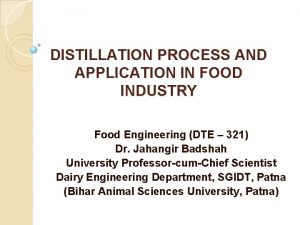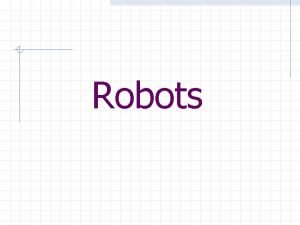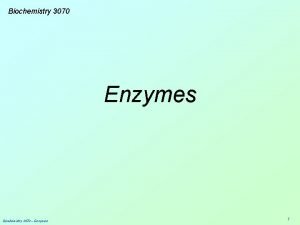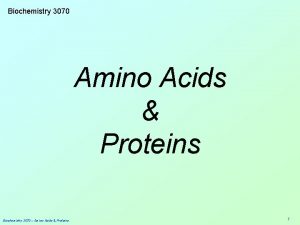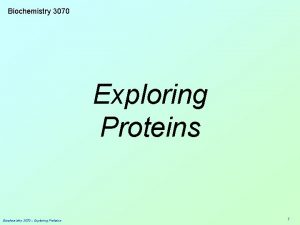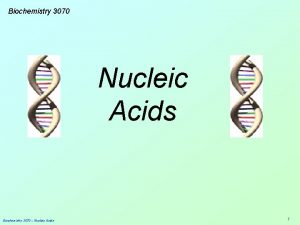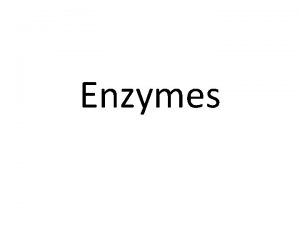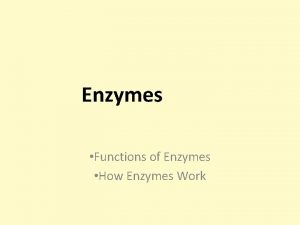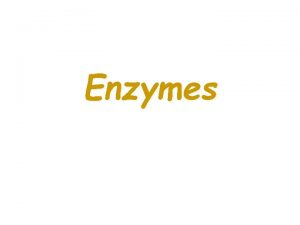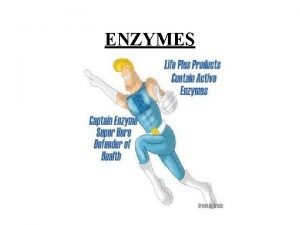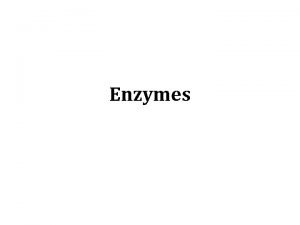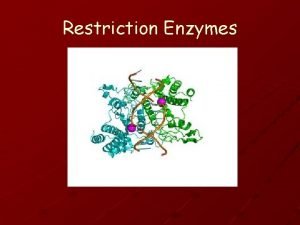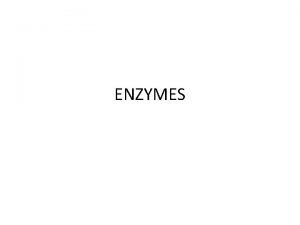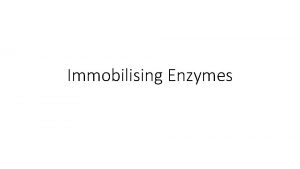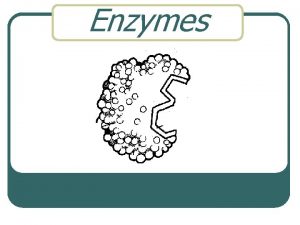Chem 3070 Industrial Applications of Enzymes The industrial


























- Slides: 26

Chem 3070

Industrial Applications of Enzymes: The industrial enzymes market was valued at $ 4. 61 billion in 2016, and is projected to reach $ 6. 30 billion by 2022.

Enzyme Applications in the Food Industry • Baking • Chocolate syrups • Candy • Infant foods • Cheese and dairy products • Egg products • Fruit juices • Alcoholic beverages • Sweeteners • Meat tenderizing • Flavor development


Sources of food enzymes: Source Enzymes Plants Amylases, glucanase, bromelain, papain, chymopapain, lipoxgenase Trypsin, chymotrypsin, pepsin, rennin, catalase, amylase, pancreatic lipase Amylase, glucose isomerase, pullunalase, cullase, invertase, microbial lipase, catalase, lactase. Animals Microorganisms

http: //www. chinaenzymes. com/index. html Sources of Industrial Enzymes

The Dairy Industry Milk is converted into yogurt, buttermilk, cheese, buttercream, soured cream by fermentation processes that depend on enzymes. Proteases, lipases, and lactases are used to develop flavor compounds. Rennin is used as a coagulant of milk to produce cheese. Lactase hydrolyzes lactose for specialized products.

The Meat Industry Protease enzymes such as papain and bromelain are used to tenderize meat by tenderizing muscle. Used in low amounts to prevent liquefaction of muscle.

Industrial Applications of Enzymes:

Industrial Applications of Enzymes (cont):

Industrial Applications of Enzymes: Uses of Amylases: • Production of sweeteners for the food and beverage industry. • Maltose syrup (low viscosity, slight sweet taste and heat stable). • Fructose production glucose →fructose by glucose isomerase.

Industrial Applications of Enzymes: Pectinases • Hydrolysis of pectin • Viscosity lowering in juices

Industrial Applications of Enzymes: Proteases Uses: • Detergents • Alkaline proteases • Stable at alkaline p. H (9 -11) • Stable at high temperatures • Pharmaceuticals • Leather processing • Food • Film • Waste processing

Beverage Industry Enzymes are used to • Reduce viscosity in fruit juices, increase production yields, volume and color. • Pectinase is used to prevent haze formation in wine (clarification).


Laundry Detergents Enzymes Proteases Amylases Lipases Cellulases Helps Remove Collar and cuff soil lines, grass stains, blood stains. Sauses, ice-creams, gravy Greasy body and food stains Dust, mud https: //www. youtube. com/watch? v=GQ 1 R-m. Fu 2 jw

Medical applications of enzymes

Challenges of Using Enzymes in Medical Treatments • Enzymes are too large to be enter many of the body’s cells. • Antigenic proteins elicit immune responses. • Effective half-life in the circulatory system may be only a few minutes. • Must be very pure and administered in very small concentrations. • Must exhibit low Km and high Vmax to be maximally efficient at low concentrations.

Cancer Treatment Asparaginase has proved to be particularly promising for the treatment of acute lymphocytic leukemia. Its action depends upon the fact that tumor cells are deficient in aspartate-ammonia ligase activity, which restricts their ability to synthesize the normally non-essential amino acid L-asparagine. Therefore, they are forced to extract it from body fluids. The action of the asparaginase does not affect the functioning of normal cells which are able to synthesize enough for their own requirements, but reduce the free exogenous concentration and so induces a state of fatal starvation in the susceptible tumor cells. A 60% incidence of complete remission has been reported in a study of almost 6000 cases of acute lymphocytic leukemia.

Fluorinase & Diels-Alder Enzymes David O’Hagen (Univ. St Andrews, UK) is using an enzyme from Streptomyces to add fluorine to organic molecules. He can add F-18 isotopes to tracers used in Positron Emission Tomography (PET) in water at neutral p. H and room temperature. “By scouring public databases, David’s team has now found their enzyme in six different bacteria. ‘We can look at the genomes and order a synthetic gene. We don’t need the organism anymore; we just order in a synthetic gene and over-express it. ” Other researchers are chasing enzymes for some of the best-known organic reactions. For example, some are hunting enzymes to catalyze the Diels–Alder reaction, one of the most powerful in synthetic chemistry. Diels–Alder reactions bring together a diene and an alkene or alkyne to create two carbon-carbon bonds in one step, forming the cyclohexane rings found in many pharmaceutical and industrial chemicals. https: //edu. rsc. org/feature/exceptional-enzymes/3007872. article

Fermentation Production of Penicillin: Penicillin is produced today using commercial producing strains of Penicillium chrysogenum that are grown using submerged cultures in constantly agitating and aerated 50, 000 -gallon stainless steel tanks. These industrial strains can now produce 40 -50 grams of penicillin per liter of culture with a 90% recovery yield. Worldwide sales of penicillin and other beta-lactam antibiotics is now greater than $15 billion (U. S. dollars) per year. These sales numbers exist despite the fact that cost is now at an all-time low. Penicillin now costs $10 per kilogram versus $300 per kilogram in 1953. https: //www. news-medical. net/health/Penicillin-Production. aspx

Ethanol Production Du. Pont's innovative enzyme technology enables the production of more than 68 billion liters of bioethanol each year. “For example, the SPEZYME® line of alpha amylase enzymes offers many advantages in the production of fuel ethanol from starch, including robust liquefaction and viscosity reduction at various temperatures and p. H levels. Combined with products such as Du. Pont™ Ferma. Sure® XL, a fermentation additive that rapidly attacks and decreases harmful bacteria, ethanol producers are increasing their ethanol fermentation rates and efficiency. ”

Industrial Applications of Enzymes: https: //phys. org/news/2019 -06 -enzyme-second-generation-ethanol-production. html JUNE 17, 2019 Modified enzyme can increase ethanol production Trichoderma harzianum, a fungus found in the Amazon, produces β-glucosidase that produces free glucose for fermentation of alcohol. In the laboratory, however, the researchers observed that high levels of glucose inhibited the activity of β-glucosidase and it is not stable at higher temperatures required for alcohol fermentation.

Industrial Applications of Enzymes: Based on an analysis of the enzyme's structure combined with genomics and molecular biology techniques, researchers were able to modify the structure to solve these problems. To arrive at the modified protein, the researchers initially compared the crystal structure of the original molecule with structures of other wild-type β-glucosidases in the GH 1 and GH 3 glycoside hydrolase families. The results of the analysis showed that glucose-tolerant GH 1 glucosidases had a deeper and narrower substrate channel than other β-glucosidases and that this channel restricted glucose access to the enzyme's active site.

Novozymes Publication on Uses of Enzymes: Enzymes at Work (pdf) https: //www. novozymes. com/en

End of Industrial Enzymes
 Po box 3070 farmington mo 63640
Po box 3070 farmington mo 63640 Ccl 3070
Ccl 3070 Distillation applications in industry
Distillation applications in industry Nn_robot
Nn_robot Các châu lục và đại dương trên thế giới
Các châu lục và đại dương trên thế giới ưu thế lai là gì
ưu thế lai là gì Các môn thể thao bắt đầu bằng tiếng đua
Các môn thể thao bắt đầu bằng tiếng đua Tư thế ngồi viết
Tư thế ngồi viết Cái miệng nó xinh thế chỉ nói điều hay thôi
Cái miệng nó xinh thế chỉ nói điều hay thôi Hình ảnh bộ gõ cơ thể búng tay
Hình ảnh bộ gõ cơ thể búng tay Mật thư tọa độ 5x5
Mật thư tọa độ 5x5 Từ ngữ thể hiện lòng nhân hậu
Từ ngữ thể hiện lòng nhân hậu Tư thế ngồi viết
Tư thế ngồi viết Chó sói
Chó sói Thẻ vin
Thẻ vin V cc cc
V cc cc Thơ thất ngôn tứ tuyệt đường luật
Thơ thất ngôn tứ tuyệt đường luật Khi nào hổ con có thể sống độc lập
Khi nào hổ con có thể sống độc lập Thế nào là hệ số cao nhất
Thế nào là hệ số cao nhất Diễn thế sinh thái là
Diễn thế sinh thái là Vẽ hình chiếu vuông góc của vật thể sau
Vẽ hình chiếu vuông góc của vật thể sau Frameset trong html5
Frameset trong html5 Làm thế nào để 102-1=99
Làm thế nào để 102-1=99 Lời thề hippocrates
Lời thề hippocrates Tư thế worm breton là gì
Tư thế worm breton là gì đại từ thay thế
đại từ thay thế Vẽ hình chiếu đứng bằng cạnh của vật thể
Vẽ hình chiếu đứng bằng cạnh của vật thể


